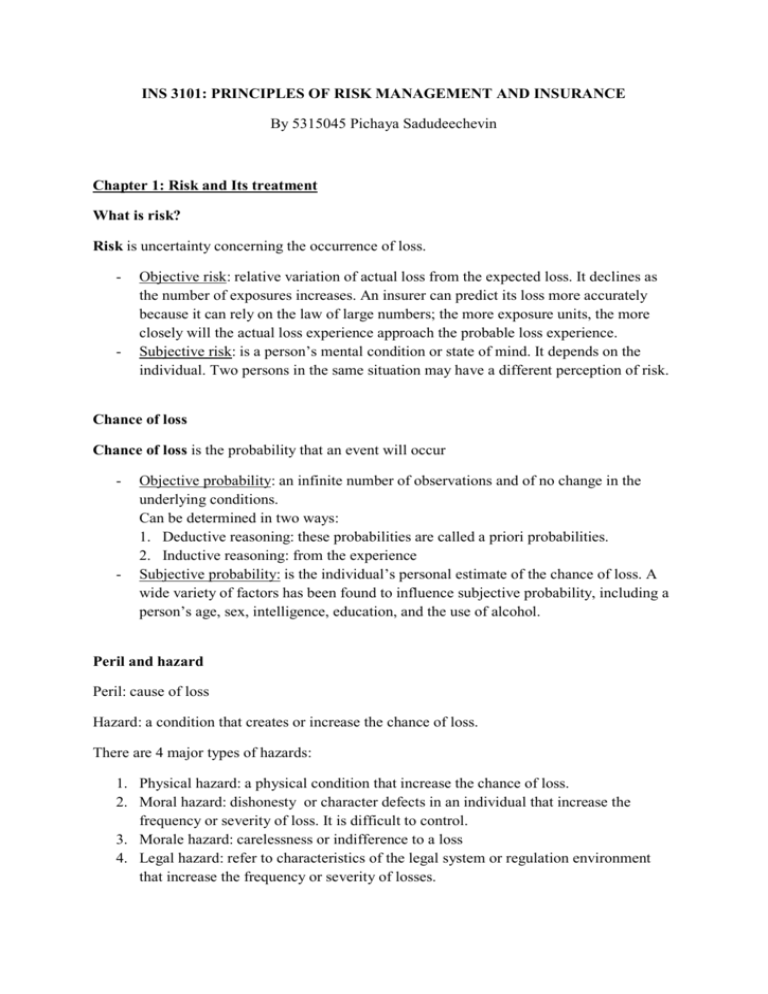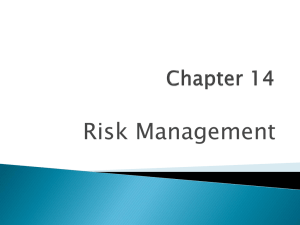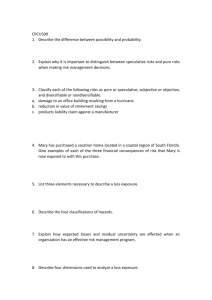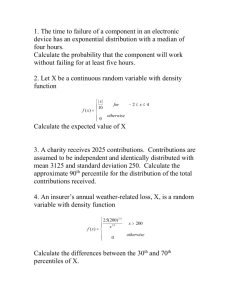INS 3101: PRINCIPLES OF RISK MANAGEMENT AND
advertisement

INS 3101: PRINCIPLES OF RISK MANAGEMENT AND INSURANCE By 5315045 Pichaya Sadudeechevin Chapter 1: Risk and Its treatment What is risk? Risk is uncertainty concerning the occurrence of loss. - - Objective risk: relative variation of actual loss from the expected loss. It declines as the number of exposures increases. An insurer can predict its loss more accurately because it can rely on the law of large numbers; the more exposure units, the more closely will the actual loss experience approach the probable loss experience. Subjective risk: is a person’s mental condition or state of mind. It depends on the individual. Two persons in the same situation may have a different perception of risk. Chance of loss Chance of loss is the probability that an event will occur - - Objective probability: an infinite number of observations and of no change in the underlying conditions. Can be determined in two ways: 1. Deductive reasoning: these probabilities are called a priori probabilities. 2. Inductive reasoning: from the experience Subjective probability: is the individual’s personal estimate of the chance of loss. A wide variety of factors has been found to influence subjective probability, including a person’s age, sex, intelligence, education, and the use of alcohol. Peril and hazard Peril: cause of loss Hazard: a condition that creates or increase the chance of loss. There are 4 major types of hazards: 1. Physical hazard: a physical condition that increase the chance of loss. 2. Moral hazard: dishonesty or character defects in an individual that increase the frequency or severity of loss. It is difficult to control. 3. Morale hazard: carelessness or indifference to a loss 4. Legal hazard: refer to characteristics of the legal system or regulation environment that increase the frequency or severity of losses. Basic Categories of Risk Pure Risk and Speculative risks Pure risk: a situation in which there are only the possibilities of loss or no loss Speculative risk: a situation in which either profit of loss is possible. Different between pure and speculative risks 1. Private insurers insure only pure risks. 2. The law of large numbers can be applied more easily to pure risk than to speculative risks. 3. Society may benefit from a speculative risk even though a loss occurs, but it is harmed if a pure risk is present and a loss occurs. 4. Fundamental and Particular Risks A fundamental risk is a risk that affects the entire economy or large numbers of persons or groups within the economy. A particular risk is a risk that affects only individuals and not the entire community. Enterprise Risks Enterprise risk: encompasses all major risks faced by a business firm. Strategic risk: uncertainty regarding the firm’s financial goal and objectives. Operational risk: the firm’s business operations Financial risk: uncertainty of loss because of adverse changes in commodity prices, interest rates, foreign exchange rates, and the value of money. Type of Pure Risks 1. Personal risks: directly affect an individual. There are four major personal risks. i. Risk of premature death: a household head with unfulfilled financial obligations which can cause financial problems. There are at least four costs that result from the premature death of a household head. a. The human life value of the family head is lost forever. b. Additional expenses may incur because of burial and probate costs, estate and inheritance taxes, and any remaining medical expenses. c. The family income from all sources may be inadequate just in terms of basic needs. d. Certain non-economic costs are also incurred such as emotional grief and loss of guidance and a role model for the children. ii. Risk of insufficient income during retirement Old age is insufficient income during retirement. iii. Risk of poor health Poor health includes both catastrophic medical bills and the loss of earned income. iv. Risk of unemployment Unemployment can result from a business cycle downswing. 2. Property risks: persons owning property are exposed to the risk of having their property damaged or lost numerous causes. There are two major types of loss associated with the destruction or theft of property. i. Direct loss: the physical damage ii. Indirect loss: a financial loss that results indirectly from occurrence of a direct physical damage or theft loss. 3. Liability risks: you can be held legally liable of you do something that result in bodily injury or property damage to someone else. Liability risks are of great importance for several reasons: i. There is no maximum upper limit with respect to the amount of the loss. ii. A lien can be placed on your income and financial assets to satisfy a legal judgment. iii. Legal defense costs can be enormous. Burden of Risk on Society 1. Large emergency fund 2. Loss of certain goods and services 3. Worry and fear Method of Handling Risks 1. Avoidance 2. Loss control - Loss prevention: reducing the probability of loss so that the frequency of losses is reduced. - Loss reduction: reducing the severity of loss after it occurs. 3. Retention i. Active Retention means that an individual is consciously aware of the risk and deliberately plans to retain all or part of it. ii. Passive retention ignorance, indifference, or laziness. 4. Noninsurance transfers i. Transfer of risk by contracts: unwanted risks can be transferred by contracts. ii. Hedging price risks: Hedging: transferring the risk of unfavorable price fluctuations to a speculator by purchasing and selling futures contracts. iii. Incorporation of a business firm If a firm is a sole proprietorship the owners’ personal assets can be attached by creditors for satisfaction of debts 5. Insurance Insurance is the most practical method for handling a major risk. Three major characteristics should be emphasized. i. Risk transfer ii. Pooling technique iii. The risk may be reduced by application of the law of large numbers. Chapter 2:The Insurance Mechanism Insurance is the pooling of fortuitous losses by transfer of such risks to insurers, who agree to indemnify the insured for such losses Basic Characteristics of Insurance 1. Pooling of Losses Pooling is the spreading of losses incurred by the few over the entire group, so that in the process, average loss is substituted for actual loss. 2. Payment of Fortuitous Losses\ Fortuitous loss is one that s unforeseen and unexpected and occurs as a result of chance. In other words, the loss bust be accidental. 3. Risk Transfer A pure risk is transferred from the insured to the insurer, who typically is in a stronger financial position to pay the loss than the insured. 4. Indemnification Indemnification means that the insured is restored to his or her approximate financial position prior to the occurrence of the loss Requirements of an Insurable Risk Before a risk can be insured with an insurer, it must meet the following requirements: • • • • • • There must be a large number of exposure units. The loss must be accidental and unintentional. The loss must be determinable and measurable. The loss should not be catastrophic. The chance of loss must be calculable. The premium must be economically feasible. 1. Large number of Exposure Units There should be a large group of roughly similar, but not necessarily identical, exposure units that are subject to the same peril or group of perils so that the insurer can accurately predict both the average frequency and average severity of loss. 2. Accidental and unintentional loss It should be fortuitous and outside the insured’s control, this means that if an individual deliberately causes a loss, he or she should not be indemnified for the loss. 3. Determinable and measurable loss The loss must be definite as to cause, time, place, and amount 4. No catastrophic loss A large proportion of exposure units should not incur losses at the same time. However, it is impossible for insurers to avoid all catastrophic losses, which periodically result from flood, hurricane, tornados, earthquake, forest fire and others. Therefore, there are two approaches are available for meeting the problem of a catastrophic loss: 1. Reinsurance can be used by which insurance companies are indemnified by reinsurers for catastrophic losses. It is the shifting of part or all of the insurance originally written by one insurer to another insurer. Then, the reinsurer is responsible for the payment of excess losses that exceed a maximum limit. 2. Insurers can avoid the concentration of risk by dispersing their coverage over a large geographic area. 5. Calculable chance of loss The insurer must be able to calculate both the average frequency and the average severity of future losses with some accuracy so that a proper premium can be charged. 6. Economically feasible premium The insured must be able to afford to pay the premium. To be an attractive purchase, the premium paid must be substantially less than the face value of the policy. Base on six requirements, most personal risks, property risks, and liability risks can be privately insured, since the requirements of insurable risk can be met. By contrast, most market risk, financial risks, production risks, and political risks are difficult to insure by private insurers because - These are speculative and so difficult to insure privately It is such a catastrophic loss It is difficult to calculate the proper premium. Adverse Selection and Insurance Adverse selection is the tendency of persons with a higher-than-average chance of loss to seek insurance at standard rates, which if not controlled by underwriting, results in higherthan expected loss levels. This can be controlled by careful underwriting. Underwriting refers to the process of selecting and classifying applicants for insurance. Insurance and Gambling Compared There are two important differences between insurance and gambling. Gambling 1. Create a new speculative risk Insurance 1. Handling an already existing pure risk 2. Socially unproductive. The winner’s gain comes from the expense of the loser. 3. Never restore the loser to insured’s financial position 2. 3. Both insurer and insured have a common interest in prevention of loss. Restore the insured in whole or part of a loss occurs Types of Insurance 1. Private insurance - Life and health insurance: benefits to beneficiaries when the insured dies. - Property and liability insurance: Property insurance-indemnifies property owners against the loss Liability insurance- covers the insured’s legal liabilities 2. Government insurance - Social insurance - Other government insurance Benefits of insurance to society 1. Indemnification for loss 2. 3. 4. 5. Reduction of worry and fear Source of investment funds Loss prevention Enhancement of credit Cost of Insurance to society 1. Cost of doing business 2. Fraudulent claims 3. Inflated claims Chapter 3: Fundamental of Risk Management Meaning of Risk Management Risk management is a process that identifies loss exposures faced by an organization and selects the most appropriate techniques for treating such exposures. A loss exposureis any situation or circumstance in which a loss is possible, regardless of whether a loss occurs. Objectives of Risk management 1. Pre-loss objectives: important objectives before a loss occurs are: i. Economy-The firm should prepare for potential losses in the most economical way. This preparation involves an analysis of safety program expenses, insurance premiums, and the costs associated with the different techniques for handling losses. ii. The reduction of anxiety-Minimize the anxiety and fear associated with the potential risks. iii. Meeting any legal obligations 2. Post-loss objectives: the risk manager also has certain objectives after a loss occurs. i. Survival of the firms – the most important post-loss objective. It means after a loss occurs, the firm can at least resume partial operation within some reasonable time period. ii. To continue operating – ability to continue operating iii. Stability of earnings – maintain the firm’s earnings per share. iv. Continued growth of the firm – risk manager must consider the impact that a loss will have on the firm’s ability to grow. v. Social responsibility - minimizes the impact that a loss has on other persons and on the society. The risk management process i. ii. iii. iv. Identify loss exposures: Identify all major and minor loss exposures. Analyze the loss exposures: estimate the potential frequency and severity of loss. Select the appropriate techniques for treating the loss exposures: A techniques can be classified broadly as either risk control or risk financing. A. Risk control o Avoidance: never acquired loss exposure, chance of loss is reduced to zero. o Loss prevention: reduce the frequency of a particular loss. o Loss reduction: reduce the severity. B. Risk financing o Retention: the firms retain part or all of the losses Paying loss: the risk manager must have some method for paying losses Self-insurance: a special form of planned retention by which part or all of a given loss exposure is retained by the firm. o Noninsurance transfers: pure risk and its potential financial consequences are transferred to another party. o Insurance: appropriate for loss exposures that have a low probability of loss but the severity of a potential loss is high. Implement and monitor the risk management program 1. Risk management policy statement 2. Cooperation with other departments 3. Periodic review and evaluation







